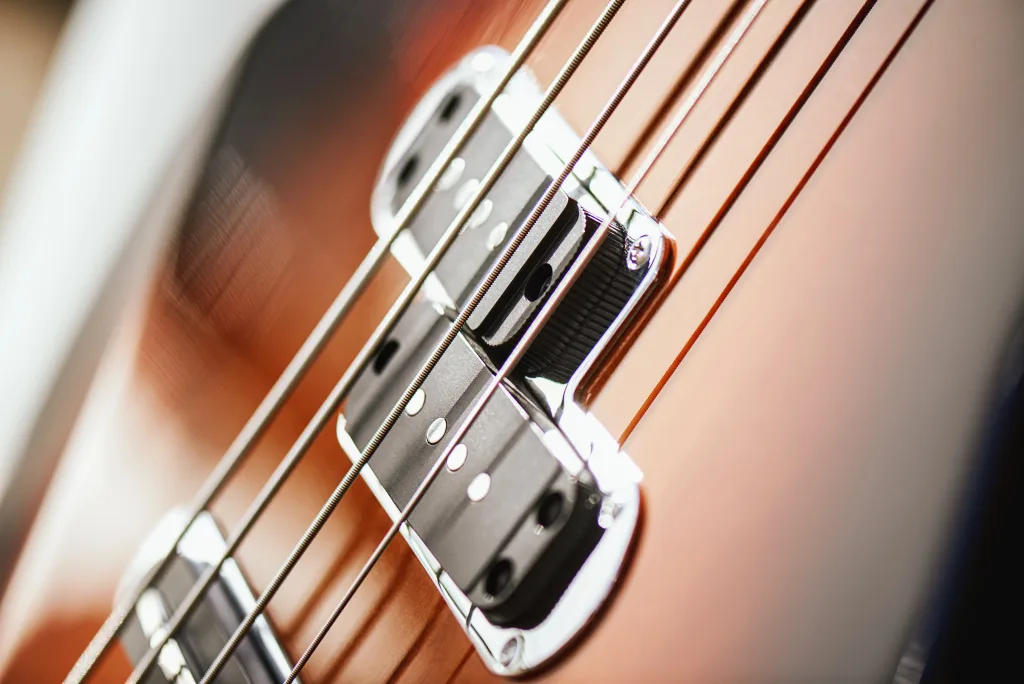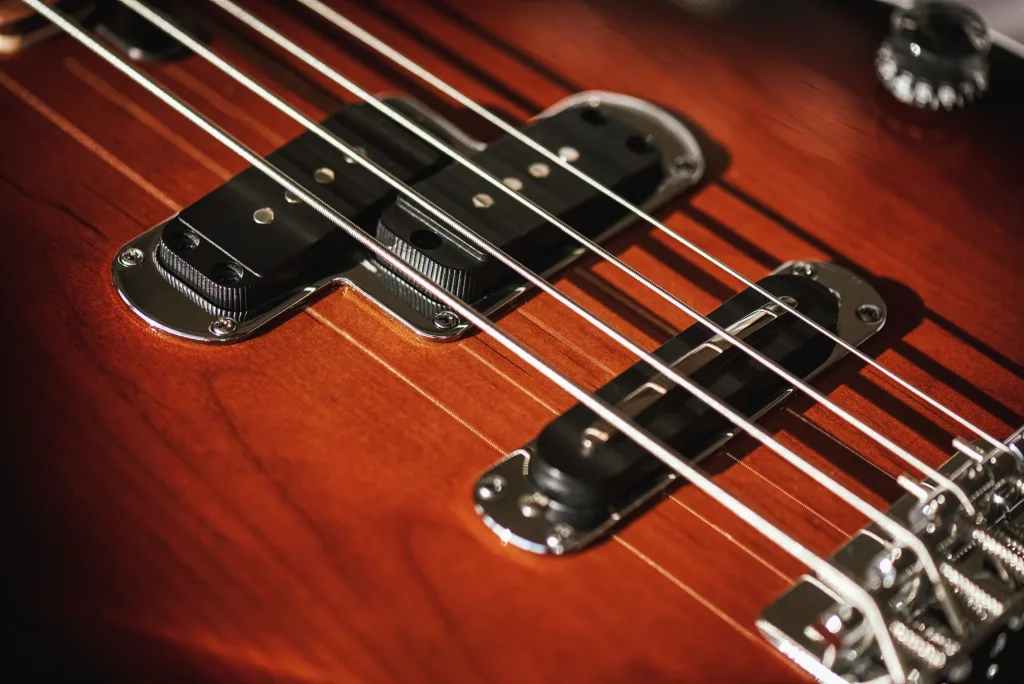Have you ever picked up an electric guitar and felt frustrated because it was so difficult to play?
You may have had the action on your guitar set too high.
Fortunately, there are ways to lower the action on an electric guitar so that it’s easier for you to enjoy playing.
In this article, we’ll discuss what guitar action is, why it’s important, how to measure it correctly, and how to lower the action on an electric guitar.
What Is Guitar Action?
The action of a guitar is the distance between the strings and frets, which affects how easily you can play each note.
If it’s too high, you need to press the strings down to make contact with the fretboard, slowing you down in your playing.
If it’s too low, you’ll start getting buzzing sounds from your guitar when you press down on the strings. You’ll also have difficulty tuning and keeping your guitar in pitch.
Finding the perfect balance between string and fret height is super important if you want to rock out on your instrument with total ease and playability.
What Is The Standard Action for Your Electric Guitar

The standard action on an electric guitar is around 4/64″ (1.6mm) on the high E string and 6/64″ (2.4mm) on the low E string.
However, personal preferences vary among electric guitarists, with some preferring lower action while others opt for higher action.
The normal electric guitar action is usually lower than acoustic guitars. If you switch from playing an acoustic guitar to trying an electric guitar in a store, you’ll likely notice the difference in action.
To find your comfort zone, start by setting your guitar to the above action height and assess how it feels. If you’re curious about achieving a lower action, try making slight adjustments and pay attention to any increase in buzzing.
If you don’t notice a significant increase in buzzing, feel free to lower the action further. Experiment with finding the lowest possible action and then determine the ideal height that suits your preferences and playability.
How to Measure Guitar Action?
Measuring the guitar’s action can help determine how easy it is to play and how hard one can push their playing.
To measure guitar action, follow these steps:
- Tune the guitar and adjust the truss rod to straighten the neck relief.
- Place an action gauge or ruler over the 12th fret, making sure that its ticks are parallel to the strings.
- Raise or lower the action as desired and take note of the measurement from the bottom of each string in order to set up your electric guitar for optimal performance.
How to Lower the Action on an Electric Guitar?

Lowering the action on an electric guitar involves considering the type of bridge it has. The method of adjusting the action height can vary depending on the bridge design.
For some electric guitars, you can individually adjust the action height for each string if the bridge allows it. This allows for fine-tuning and customization, ensuring optimal playability for every string.
However, certain bridges may only allow you to adjust the action height across the entire bridge as a whole. In such cases, the adjustment affects all strings collectively rather than individually.
When aiming to lower the action on your electric guitar, understanding the capabilities of your specific bridge is key in determining the level of adjustment you can achieve.
How to Lower the Action on Tune-o-Matic Bridges
To lower the action on the Tune-o-Matic bridge, you must adjust the screws on the bridge posts to lower or raise the action on each string.
- Start by measuring the action height on your low E string and then adjusting its corresponding screw.
- Once you’ve set it to your desired height, re-tune the guitar and measure again for accuracy.
- Then, do the same for your high E string.
If either of these strings’ actions is too low, you may need to compromise and raise them overall instead of individually adjusting them.
How to Lower the Action on Floyd Rose Bridges
Adjusting the action on a Floyd Rose bridge requires precision and can be quite tricky, so it’s important to make sure everything is set up correctly before making any adjustments.
To do this, use an Allen wrench (3mm) to adjust the height of each post. It’s important to note that if your Floyd Rose bridge looks imbalanced in its resting position, you need to fix it before attempting to adjust the action.
If not, you’ll likely find that the action becomes too high for comfortable playing.
Once the tension balance has been addressed, then you can proceed with adjusting the action posts using an Allen wrench until your desired height is achieved.
How to Lower the Action on Fender-style Bridges
To lower the action on a Fender-style bridge, you need to use a 1.5mm Allen wrench to adjust two screws on each saddle.
Make sure both height screws are set at the same level so that the saddle remains flat.
If you want added precision, you can buy an under-string radius tool that allows you to perfectly match the radius of the fretboard when adjusting each string’s action.
To use this tool, start by adjusting the action for both E strings then rest it against all other strings one by one until they touch it and make sure none of them buzz against it.
What causes high action on a guitar?
High action on a guitar can be caused by several factors:
The level of Temperature and Humidity
Excess heat and moisture can cause your guitar’s neck to warp, making it difficult to play.
High temperatures and humidity levels impact the wood of a guitar and can cause issues like back-bow, where the neck is no longer flat, or relief when there is an upward curve in the neck that causes high action.
Here are three key elements to consider when dealing with temperature and humidity:
- Avoid drastic and rapid changes in temperature or humidity levels.
- Look out for signs of warping, such as a back-bow or relief on the neck.
- Make sure you adjust the truss rod accordingly if you notice any changes in your guitar’s shape due to heat or moisture exposure.
It’s important to be mindful of these elements in order to keep your instrument playing at its best.
Changes in String Tension
The changes in string tension can cause a back bow or relief in the neck, making it difficult to play.
If this happens, you’ll need to adjust the truss rod (located inside the neck) by turning it clockwise or counterclockwise until the desired amount of bow has been achieved.
Additionally, when changing between sets with different tensions, there might be an adjustment period as well as some tuning issues due to stretching or settling in of new strings.
To ensure that your electric guitar has action at its optimal level for comfortable playing while avoiding any string buzz, experiment with adjusting both truss rod and bridge height adjustments accordingly.
Conclusion
With a few simple steps, you can make your guitar easier to play and enjoy the music more.
And if you ever experience any issues with high-action again, now you know how to fix it quickly and easily.
FAQ
What tools are needed to lower the action on an electric guitar?
Lowering the action on an electric guitar requires a few tools: a ruler, a truss rod wrench, and an adjustable bridge.
Is it possible to lower the action on an acoustic guitar?
Yes, it’s possible to lower the action on an acoustic guitar. However, there are some differences between electric and acoustic guitars that make this process a bit more complicated than adjusting the action on an electric.
Are there any risks associated with lowering the action on a guitar?
Yes, there are risks associated with lowering the action on a guitar.
If done incorrectly, it could cause the neck of your guitar to bow or warp, causing intonation issues and fret buzz.
What type of strings should be used to lower the action on an electric guitar?
For lowering the action on an electric guitar, lighter gauge strings are best, as they require less tension to reach the desired pitch. However, there are trade-offs with using lighter strings: they may not last as long and can also produce a slightly thinner sound than heavier gauge strings.
Will lowering the action on an electric guitar affect the sound of the guitar?
Lowering the action on an electric guitar can affect the instrument’s sound. The lower you set the strings, the less sound will be able to project from the body and neck of your guitar.
You may also notice a slight change in tone due to how close or far away your pickups are from your strings. Lowering your action too much can cause buzzing, so it’s important to find a balance between having low action and avoiding buzzes.
Also, you can check out our tips on How to Make Your Electric Guitar Sound Better.

